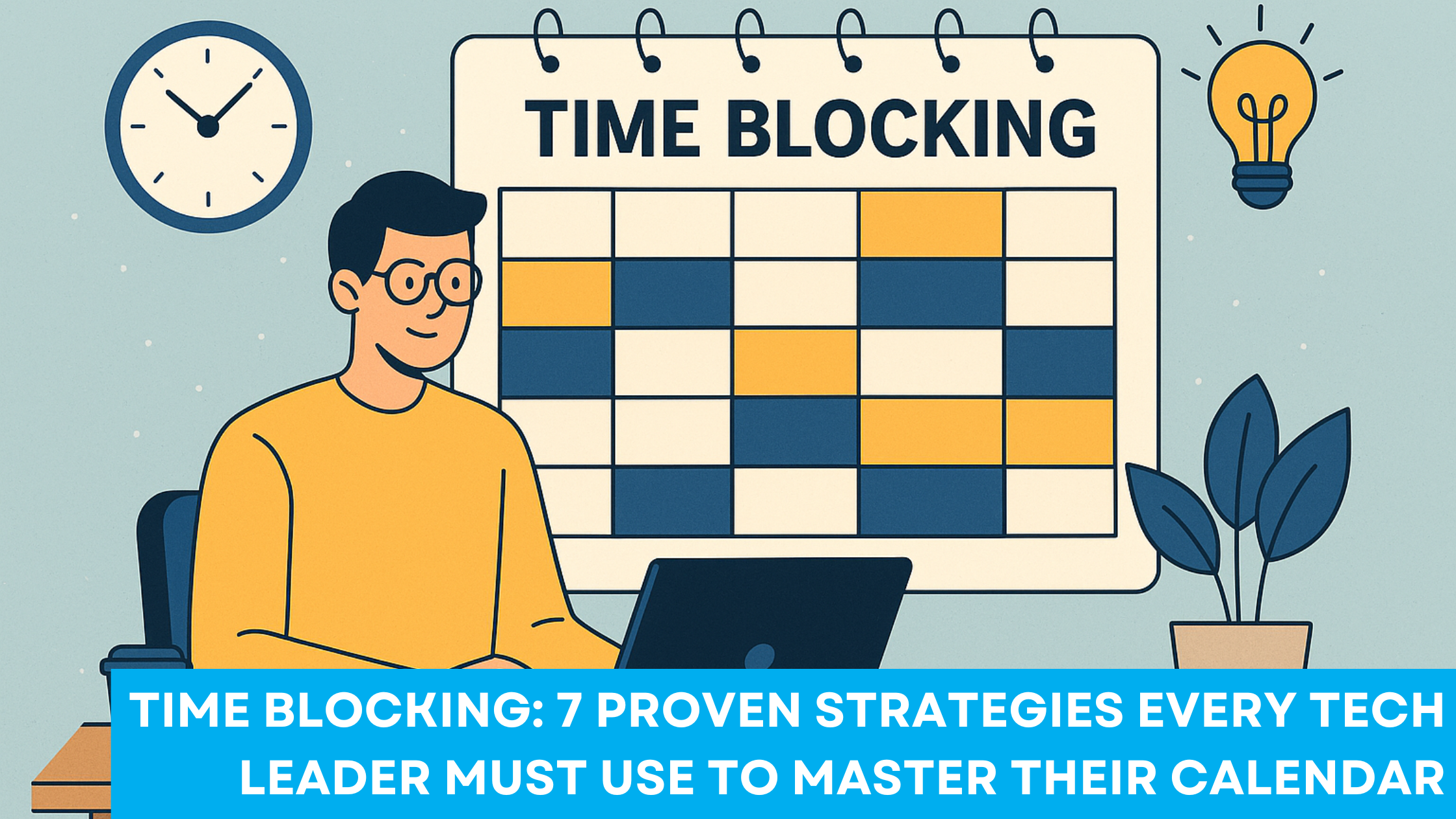Key Takeaways
- Time blocking helps tech leaders shift from calendar chaos to strategic control.
- In fast-moving environments, disciplined blocks reduce context-switching and elevate high-impact work.
- Core components—block design, labeling, transitions, and review—determine success.
- A five-step process embeds time blocking into your leadership rhythm.
- Recognizing and fixing common pitfalls ensures lasting productivity gains.
As a senior leader in a technology organization, you face relentless velocity—global teams, distributed workflows, constant releases, and competing priorities.
Your calendar often feels like a passenger seat rather than the driver’s. You’re busy, yet strategic time disappears.
In this reality, mastering time blocking isn’t a productivity trick—it’s a leadership imperative. Your ability to lead depends not only on what you do but on how intentionally you protect time for reflection, planning, and high-leverage work.
Time blocking enables you to reclaim your calendar and lead from intention, not reaction.
What Is Time Blocking (and Time Boxing)?
Time blocking is the structured practice of dividing your workday into dedicated blocks of time, each assigned to a specific purpose. It reduces context switching and ensures your most valuable work gets the focus it deserves.
A related technique—time boxing—sets a fixed time limit for a task and stops when the time expires. According to productivity experts, time blocking protects your time from others; time boxing protects your time from yourself.
In tech leadership—where cognitive load, interruptions, and stakeholder demands are constant—these methods provide the mental structure needed to think clearly, prioritize, and execute decisively.
Why It Works in Tech Leadership
In the tech industry, your role isn’t just to execute tasks—it’s to steer vision, scale systems, and empower teams. Research shows that knowledge workers who intentionally structure their time perform better and report less stress.
Frequent context switching, by contrast, can reduce productivity by up to 40%, according to cognitive performance research.
Therefore, when tech leaders consistently use time blocking, they model focus and intentionality. It not only enhances personal performance but also shapes organizational culture toward deeper work and clearer priorities.
Key Components of Effective Time Blocking
| Key Component | Action | Example | Risk if Ignored |
| Block Design | Define meaningful time segments aligned with strategic goals | Monday 9–11 am “Tech Roadmap & Innovation” | Day becomes reactive; strategic work sidelined |
| Labeling & Priority | Assign each block a clear purpose and value | “Team Coaching & Growth” instead of “Admin” | Blocks drift into low-value busywork |
| Buffer & Transition Time | Insert transition windows to reset between contexts | 15-minute buffer after deep work before meetings | Fatigue, poor focus, meeting burnout |
| Stop or Switch Rule | For time boxing, stop when the time expires | 45-minute box for “Review architecture options” | Tasks drag, decisions delayed |
| Review & Adjust | Conduct a weekly reflection to improve rhythm | Friday 4 pm “Did I protect my strategic blocks?” | No feedback loop; schedule misalignment repeats |
Five-Step Practical Guide for Tech Leaders
1. Audit your current calendar.
Export your past week’s schedule. Categorize every item as reactive (meetings, interruptions) or proactive (vision, team development, innovation). Many leaders discover that 60–70% of their time is spent on reactive work.
2. Define your leadership buckets.
Identify 3–5 priority areas: Vision & Innovation, Team Capability Building, Stakeholder Alignment, and Operational Oversight. Assign approximate percentages based on strategic value.
3. Schedule fixed blocks for next week.
Book time for proactive work before reactive tasks appear. Example: Monday & Wednesday 9–11 am “Innovation & Roadmap”; Tuesday 1–2 pm “Team Development”; Friday 3–4 pm “Reflection & Buffer.” Treat these as non-negotiable meetings with yourself.
4. Communicate and protect your blocks.
Tell your team and peers these are protected times. When new requests conflict, delegate or reschedule—but never cancel. Consistency signals discipline.
5. Review weekly and refine.
Every Friday, ask: Did I honor my blocks? What got interrupted? Why? Adjust timing, duration, or structure based on those insights.

Real-World Tech Executive Example
A CIO at a global SaaS company implemented time blocking by reserving two 2-hour blocks each week for “Emerging Technology & Architecture Exploration.”
After six months, the number of high-priority roadmap items completed increased by 28%, unplanned escalation meetings dropped 21%, and his personal meeting load declined 15%—freeing four hours per week for strategy.
By treating the calendar as a leadership asset, he enhanced both performance and perception of executive focus.
Common Pitfalls and Practical Solutions
| Pitfall | Solution |
| Blocks are too rigid in a fast-changing environment | Use shorter (60–90 min) sessions and allow limited flexibility. |
| Underestimating transition costs | Include 10–15-minute buffers between focus sessions and reactive tasks. |
| Scheduling blocks unrelated to your top priorities | Begin with your core strategic objective, then design blocks around it. |
| Failing to review or adapt regularly | Add a recurring weekly reflection to refine block rhythm. |
| Using blocks as filler rather than purpose-driven time | Label each block with a tangible outcome (“Coach two engineers,” “Prototype UI concept”). |
From Strategy to Rhythm
In tech leadership, strategy often dies in the weeds of execution.
Time blocking bridges that gap—it turns intent into rhythm.
When your calendar reflects your leadership priorities, you free mental space for innovation, people, and systems thinking.
It’s not about doing more—it’s about protecting what truly matters.
Reflective Close
Look at next week’s calendar.
Does it reflect the leadership agenda you believe in—or simply the demands that found you?
What one block will you create and defend this week that no one else will schedule for you?
That block defines your leadership.



